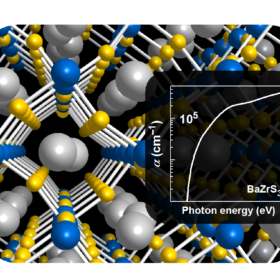
Japanese researchers have identified a perovskite material with strong band edge gap and high stability which they say could offer 38.7% efficiency if used in BaZrS3-alloy top cell and c-Si bottom cell architecture with a thin top cell thickness of 550nm.
Scientists from Japan’s Gifu University and the Tokyo Institute of Technology have identified a chalcogenide perovskite material with light absorption attributes strong enough to offer the potential for theoretical maximum conversion efficiency of 38.7% in a silicon perovskite tandem solar cell.
The material – BaZrTiS3 – has a light absorption coefficient exceeding 105cm-1, the highest of all existing solar cell materials, including chalcogenide perovskites such as SrZrS3, BaHfS3 and SrHfS3, the scientists claim.
“High stability of this material for temperature (<600C) and water immersion has already been confirmed,” they wrote in the paper Extraordinary Strong Band‐Edge Absorption in Distorted Chalcogenide Perovskites, published in RRL Solar.
The researchers explained that, thanks to the material’s strong band edge gap, the light penetration becomes quite small, thus enabling an easier collection of photogenerated carriers, which is crucial in addition to the sufficient light absorption.
The scientists said that all other existing solar cell materials, including hybrid perovskites, show rather small absorption coefficients in the bandgap transition region, and that their weak band-edge light absorption is an inherent problem, which limits efficiency particularly in tandem solar cells.
“As a top-cell material of a chalcogenide perovskite/c-Si tandem solar cell, BaZrS3-based alloys including Ba(Zr0.95Ti0.05)S3 and BaZr(S0.6Se0.4)3 have been fabricated,” the paper notes. “Our device simulation shows that 38% efficiency can be reached in a BaZrS3-alloy top cell and a c-Si bottom cell architecture with a thin top cell thickness of 550 nm.”
The researchers believe that, with a proper thin-film formation technology, their new technology can be transferred to mass production of perovskite-based PV panels.
In December, researchers from Lehigh University in Pennsylvania announced the results of a study to map the lattice thermal energy transport mechanism of another chalcogenide perovskite for solar and thermoelectric applications – CaZrSe3.
A month later, researchers from the University at Buffalo, in New York state, unveiled a thin-film made of chalcogenide perovskite barium zirconium sulfide (BaZrS3), which they claim demonstrates very strong light absorption and good charge transport.
Metal chalcogenide perovskites, with their non-toxic elemental composition, are known to offer greater thermal and aqueous stability than organic-inorganic halide perovskites.
Lắp đặt điện mặt trời Khải Minh Tech
https://ift.tt/2X7bF6x
0906633505
info.khaiminhtech@gmail.com
80/39 Trần Quang Diệu, Phường 14, Quận 3
Lắp đặt điện mặt trời Khải Minh Tech
https://ift.tt/2ZH4TRU
Không có nhận xét nào:
Đăng nhận xét